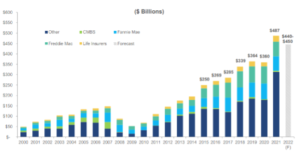
Jerome Powell Rings the Bell on Housing
For those not watching the Q&A session of the FED meeting yesterday, in the most diplomatic way possible, Mr. Powell said, “…probably in the housing market [we] have to go through a correction to get back to normal.” He probably wanted to say something to the effect of “I hope you enjoyed the last 12 years because the days of cheap money are over.” Either way, the FED just rang the bell signaling the end of recess, but specifically for the housing market.
Roughly 1/3 of the Consumer Price Index (CPI) is shelter, so it shouldn’t surprise anyone that housing is squarely in the bullseye of the FED. The BLS defines shelter as the following:
“The shelter service that a housing unit provides to its occupants is the relevant consumption item for the CPI. Most of the cost of shelter for renter-occupied housing is rent. For an owner-occupied unit, most of the cost of shelter is the implicit rent that owner-occupants would have to pay if they were renting their homes, without furnishings or utilities.”
Reading between the lines, it sounds like they approximate $/SF for your city/zip code and assign an equivalent rent for owner-occupied units. That makes up roughly 80% of the shelter component or 24% of the total CPI. What’s not included in the shelter component of CPI (outside of furnishings and utilities noted above):
- Property Taxes
- Mortgage Interest
- Most Repairs & Maintenance
- Capital Improvements
Stepping back to digest everything, the FED disregards the growth in most operating expenses—especially the biggest ones—and is squarely focusing on rent increases. In plain talk, “I don’t care about your expense growth, but your YoY rent bumps are toast.” Maybe a more appropriate name for this article would have been, “RIP Value-Add Multifamily Investing,” but then I worried people would have been biased from the on-set and would not read this far to understand the facts I have set forth. What does this likely mean? In order to get inflation to roll over and some level of hope that rates will come back down, the FED needs to see a material slowdown in rent growth.
It’s hard to look past the fact that multifamily investors have been feasting at the table of cheap debt and high leverage for the better part of the last ten years. Just look at this table in a FMAC securitization presentation from June of this year.

The title of the slide was, “Originations increased significantly in 2021 and are projected to remain relatively high in 2022 reflecting solid market fundamentals.” The perceived strength and fundamentals of the housing sector have allowed most of the participants to look past the biggest risk to the space that has been growing at an accelerating pace—housing as a sector has become incredibly leveraged. Where and when does this become a problem? For starters, much of that dark blue shaded bar in 2021 labeled, “other,” is floating rate debt originated when indexes where range bound at 0-25bps predicated entirely on one thing, rent growth over the next 1-3 years. Back to the schoolyard analogy, you have the FED on one side of the court and the value-add multifamily guys on the other, with rate caps maturing on their floating rate debt and refinance options 200-300bps higher than where they were a year ago. As Terrell Owens famously said, “Get your popcorn ready.”
Do I really believe value-add multifamily investing is over, I absolutely do not. Renters are constantly turning over, lifestyles are always changing, and demands for more space and less space seem to ebb and flow over the course of our lives. Good investors are always recognizing changes in trends and can anticipate ways to enhance the lifestyle of their renters. However, Jerome Powell has said specifically that there will be pain, and multifamily may bear an outsized portion of it, for no other reason than it is just highly leveraged and debt isn’t cheap anymore. Keep in mind, some of the best buying opportunities will present themselves soon, and as my neighbor reminded me this morning, this is when the next Sam Zell is made. And more good news, buyers will no longer have to overpay on deals to realize the sellers’ upside in rents.
“Waiting for rates to go back down,” is not an investment philosophy taught in business school.
Will rates go back down, maybe, but could they continue to go up, absolutely. Your three largest holders of US treasuries, The Fed, China, and Japan, are either not buying anymore, or starting to sell their holdings. For the history buffs out there, last Thursday, September 15th was the day the FED stopped buying mortgage-backed securities for good (for now.) The irony of that date, 14 years ago to the day was September 15th, 2008 – the day Lehman Brothers declared bankruptcy.
All is not lost if you are sitting in floating-rate debt (including construction loans) that are maturing over the next 12-24 months, however, I would advise you to be proactive and explore your options sooner rather than later. At Slatt Capital, we continue to be very active in the debt and equity markets, and helping clients find solutions for their needs is what we are here for. I would submit the worst decision an investor can make right now is indecision.
John Darrow
Principal
D: 949.335.7821
john.darrow@slatt.com